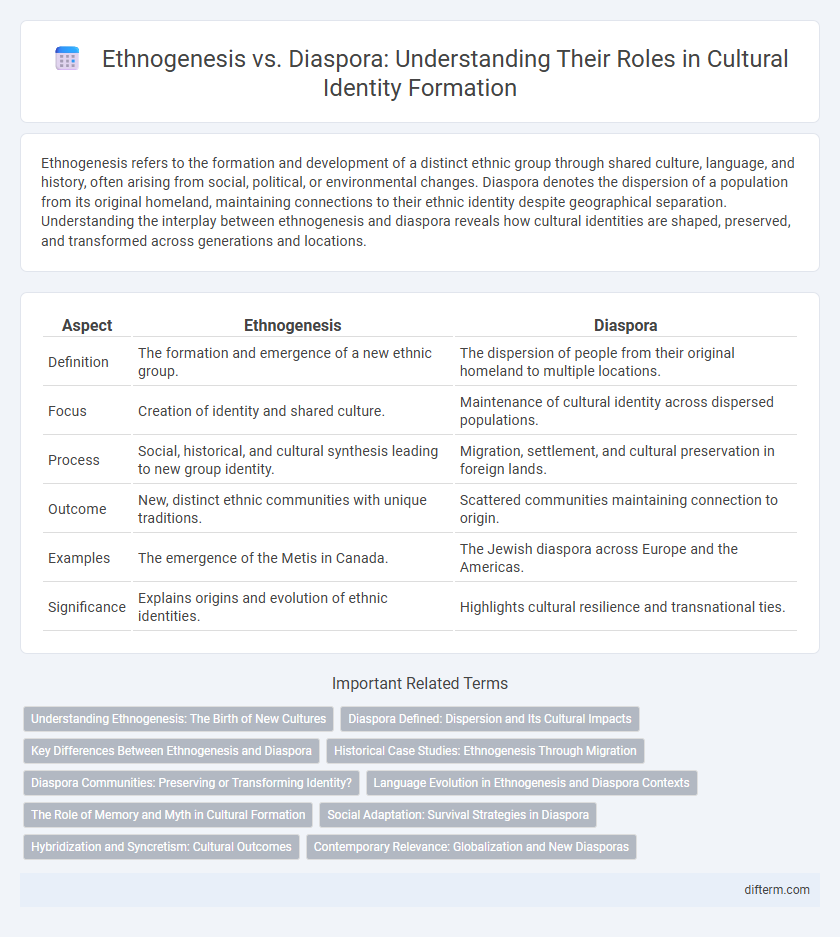Ethnogenesis refers to the formation and development of a distinct ethnic group through shared culture, language, and history, often arising from social, political, or environmental changes. Diaspora denotes the dispersion of a population from its original homeland, maintaining connections to their ethnic identity despite geographical separation. Understanding the interplay between ethnogenesis and diaspora reveals how cultural identities are shaped, preserved, and transformed across generations and locations.
Table of Comparison
| Aspect | Ethnogenesis | Diaspora |
|---|---|---|
| Definition | The formation and emergence of a new ethnic group. | The dispersion of people from their original homeland to multiple locations. |
| Focus | Creation of identity and shared culture. | Maintenance of cultural identity across dispersed populations. |
| Process | Social, historical, and cultural synthesis leading to new group identity. | Migration, settlement, and cultural preservation in foreign lands. |
| Outcome | New, distinct ethnic communities with unique traditions. | Scattered communities maintaining connection to origin. |
| Examples | The emergence of the Metis in Canada. | The Jewish diaspora across Europe and the Americas. |
| Significance | Explains origins and evolution of ethnic identities. | Highlights cultural resilience and transnational ties. |
Understanding Ethnogenesis: The Birth of New Cultures
Ethnogenesis refers to the process by which new cultural identities and ethnic groups emerge through shared experiences, languages, and traditions. This dynamic formation contrasts with diaspora, where a dispersed community maintains its original cultural identity across different regions. Understanding ethnogenesis reveals how historical events, migration, and social interactions contribute to the birth and evolution of distinct cultures over time.
Diaspora Defined: Dispersion and Its Cultural Impacts
Diaspora refers to the dispersion of a population from their original homeland to multiple geographic locations, often resulting in the creation of transnational communities. This movement influences cultural identities by fostering hybridization, preserving ancestral traditions, and facilitating the exchange of cultural practices across borders. The cultural impacts of diaspora include the development of multifaceted identities and sustained connections to both the host and origin societies.
Key Differences Between Ethnogenesis and Diaspora
Ethnogenesis refers to the formation and development of a distinct ethnic group through shared heritage, culture, and identity, often emerging from historical, social, or political processes. Diaspora describes the dispersion of people from their original homeland to multiple geographic locations, maintaining cultural connections despite physical separation. Key differences include ethnogenesis as the creation of a new ethnic identity, whereas diaspora emphasizes the spread and maintenance of an existing ethnic group's culture across different regions.
Historical Case Studies: Ethnogenesis Through Migration
Ethnogenesis through migration is exemplified by the emergence of the Anglo-Saxons, who formed a new cultural identity in Britain after migrating from continental Europe during the early medieval period. This process involved the blending of indigenous Britons with incoming Germanic tribes, leading to distinct linguistic, social, and political structures. Such historical case studies illustrate how migration can spur the formation of new ethnic groups, contrasting with diaspora communities that maintain dispersed identities anchored to an ancestral homeland.
Diaspora Communities: Preserving or Transforming Identity?
Diaspora communities navigate the complex process of preserving their cultural identity while adapting to new social environments, balancing traditions with the influences of host societies. These communities actively engage in cultural practices, language retention, and communal events to maintain a sense of belonging, yet their identities often evolve through intergenerational exchange and hybridization. The dynamic interplay between preservation and transformation in diaspora settings highlights the fluid nature of cultural identity beyond original ethnogenesis.
Language Evolution in Ethnogenesis and Diaspora Contexts
Language evolution in ethnogenesis reflects the blending and emergence of new linguistic forms as distinct groups merge and redefine their cultural identity, often resulting in creole or pidgin languages. In diaspora contexts, language change is influenced by contact with host cultures, leading to bilingualism, language shift, or maintenance depending on community cohesion and generational transmission. Both processes shape identity, with ethnogenesis fostering innovative linguistic traits tied to new ethnic identities, while diaspora dynamics create hybrid languages that navigate between origin and host cultures.
The Role of Memory and Myth in Cultural Formation
Memory and myth serve as crucial foundations in the process of ethnogenesis by preserving collective identity and shared narratives that define a group's origins and values. In diaspora communities, these reconstructed memories and myths reinforce cultural continuity despite geographic dispersion and external influences. The interplay of remembered history and symbolic storytelling shapes both the sense of belonging and the dynamic evolution of cultural identity across generations.
Social Adaptation: Survival Strategies in Diaspora
Ethnogenesis involves the formation of new ethnic identities through social adaptation and collective memory, serving as a survival strategy in diaspora communities. Diaspora groups develop dynamic cultural practices and social networks to negotiate identity and maintain cohesion amid external pressures. This adaptive process often includes language retention, religious rituals, and intergenerational transmission of heritage to sustain community resilience.
Hybridization and Syncretism: Cultural Outcomes
Ethnogenesis and diaspora both contribute to cultural hybridization and syncretism, where distinct traditions merge to create new, dynamic identities. Ethnogenesis often results in the formation of novel ethnic groups through blending hereditary and cultural elements, while diaspora communities adapt by integrating host cultures with ancestral practices. These processes drive cultural diversity, fostering hybrid languages, rituals, and social structures that reflect complex historical interactions.
Contemporary Relevance: Globalization and New Diasporas
Ethnogenesis shapes identity by blending cultural traits, crucial in globalized societies where migration forms new diasporas. These diasporas maintain transnational connections, fostering hybrid identities that challenge static notions of ethnicity. Globalization accelerates cultural exchange, making ethnogenesis a dynamic process integral to understanding contemporary diaspora experiences.
Ethnogenesis vs Diaspora Infographic

 difterm.com
difterm.com